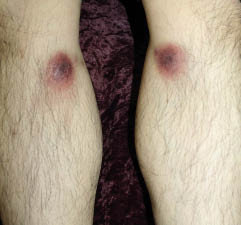Woon-Kyong Chung, Myoung-Shin Kim, Chae-Hwa Kim, Mi-Woo Lee*, Jee-Ho Choi, Kee-Chan Moon and Jai-Kyoung Koh
Department of Dermatology, University of Ulsan College of Medicine, Asan Medical Center, 388-1 Pungnapdong, Songpagu, Seoul, 138-736, Korea.
*E-mail: 1052_hihi@hanmail.net
Accepted April 27, 2009.
Sir,
Mycobacterium chelonae exists widely in soil, fresh water, and dust throughout the world and is usually non-pathogenic in humans. The organism is a rapidly growing mycobacterium, and belongs to the Runyon group IV classification. Cutaneous M. chelonae infections can be classified into two types according to patient immune status. In immunocompetent patients, lesions usually follow trauma and present as localized abscesses, nodules, erythemas, or ulcers. In immunocompromised patients, however, lesions frequently develop without any trauma, and show a sporotrichoid or disseminated pattern. We report here a case of a 52-year-old immunocompetent man with bilateral symmetrical lesions but no history of trauma.
CASE REPORT
A 52-year-old Korean man visited our clinic with bilateral symmetrical reddish plaques on both shins. Six weeks earlier, a single 0.5 cm papule had developed on the right shin, and became gradually larger. Two weeks later, a similar lesion had developed on the left shin. Mild tenderness was noted. The patient was otherwise healthy without hepatitis or HIV infection, and denied any history of trauma or iatrogenic procedures.
Skin examination revealed two 3–4 cm erythematous-to-purpuric round flaccid plaques, with surrounding erythema, on the medial side of both shins (Fig. 1). Routine laboratory test data, including blood tests, and chest roentgenogram results, were all within normal limits. Histopathological examination showed suppurative inflammation composed of neutrophils, histiocytes, and lymphocytes. Although no acid-fast bacilli were observed on Ziehl-Neelsen staining, mycobacterial culture grew ivory-coloured wet colonies, which were identified as M. chelonae by polymerase chain reaction-restriction fragment length polymorphism assessment. In vitro testing of drug susceptibility revealed that the organism was susceptible to clarithromycin, tobramycin, and linezolid, and, among these, the minimum inhibitory concentration (MIC) of clarithromycin was lowest at 0.25 μg/ml. Drainage was performed at the time of skin biopsy, and the patient was treated with 1 g of clarithromycin orally per day. After 13 weeks of treatment, both lesions had almost disappeared.
Fig. 1. Two 3–4 cm erythematous-to-purpuric round flaccid plaques, with surrounding erythema, on the medial sides of both shins.
DISCUSSION
Cutaneous M. chelonae infections occurring as multiple lesions in immunocompetent patients without a history of trauma or iatrogenic procedures have rarely been reported (1–3). In the present case, despite normal immune function, our patient showed bilateral symmetrical lesions on both shins, and denied trauma. It is not clear why bilateral lesions occurred symmetrically on both shins. The probability of autoinoculation from the earlier lesion on the right to the one on the left seems low. Although the anteromedial sides of the shins are close together, they do not generally come into anatomical contact. Although a single case of cutaneous M. chelonae infection with bilateral sporotrichoid involvement has been reported (2), symmetrical lesions on both shins, without any lesions on the more proximal parts of the legs, are not enough to allow the “sporotrichoid” designation to be assigned. Although some authors have suggested that disseminated cutaneous disease should be defined as the presence of > 5 nodular subcutaneous lesions (4), the bilateral lesions of our patient are better explained as arising from dissemination.
The reason why two symmetrical plaques appear only on the shins is unclear. The relatively sparse arterial vasculature in the shins and gravitational effects causing blood stasis in the venous system may play a role. Moreover, the lymphatic system in this area may be inadequate, and the skin of the upper shins has no underlying muscle pump to avoid removal of tissue fluid.
Rapidly growing mycobacteria including M. chelonae are usually resistant to anti-tuberculosis medications (5). Clarithromycin has been reported to be the most effective drug for treating M. chelonae infection (6–9). In our case, the in vitro M. chelonae susceptibility study revealed that clarithromycin showed the lowest MIC of several drugs tested. After 13 weeks of clarithromycin treatment, both lesions had almost disappeared.
In summary, cutaneous M. chelonae infections may develop in immunocompetent patients without any trauma history, and dissemination can also occur. Moreover, in M. chelonae infections, bacilli are frequently not observed after staining with either of haematoxylin/eosin or the Ziehl-Neelsen reagents, making accurate diagnosis difficult. Informed suspicion and early mycobacterial culture are therefore required.
REFERENCES




